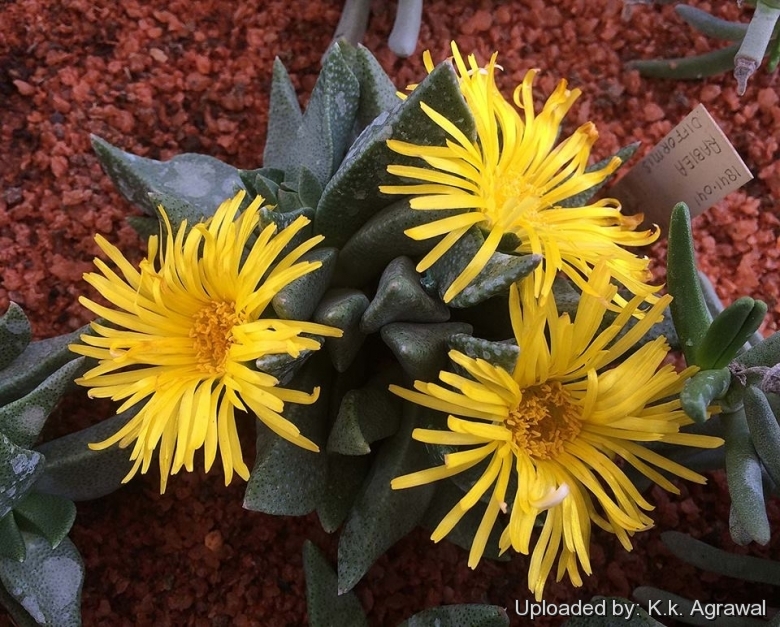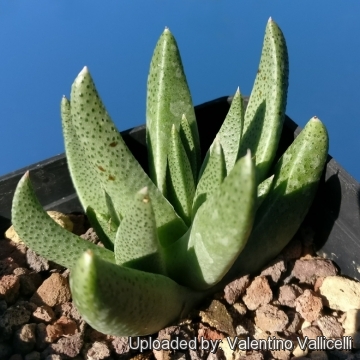
Rabiea difformis Photo by: K.k. Agrawal
Origin and Habitat: Cradock District, Eastern Cape, South Africa.
Synonyms:
Description: Rabiea difformisSN|19625]]SN|26038]] is a low-growing matt-former from South Africa. Not as well known as Rabiea albinotaSN|26038]]SN|19625]], but leaves and habit of growth are similar and flowers practically same.
Leaves: Leaves of a pair different: one leaf tapering gradually from a broad base towards the pointed tip, the other developing a moderate thickening below the apex, both rough from dots, to 40 mm 1, to 9 mm b at the broadest part.
Flowers: Waxy yellow, petals golden, 9-21 mm long, to 2 mm broad, filaments and anthers golden, 5 glands.
Blooming: Supposed to bloom mostly in spring and summer, but seems to bloom almost randomly.
Roots: Tuberous.
Bibliography: References and further reading
1) Oliver, I.B. “Grow succulents.” Kirstenbosch Gardening Series. National Botanical Institute, Cape Town.
2) Smith, G.F., Chesselet, P., Van Jaarsveld, E.J., Hartmann, H., Hammer, S., Van Wyk, B-E., Burgoyne, P., Klak, C. & Hubert, K. “Mesembs of the world.” National Botanical Institute, Pretoria.1998.
3) Doreen Court “Succulent Flora of Southern Africa” CRC Press, 01/giu/2000
4) James Cullen, Sabina G. Knees, H. Suzanne Cubey “The European Garden Flora Flowering Plants: A Manual for the Identification of Plants Cultivated in Europe, Both Out-of-Doors and Under Glass - Casuarinaceae to Aristolochiaceae” Cambridge University Press, 11/ago/2011
5) Hermann Jacobsen, Vera Higgins “Succulent Plants: Description, Cultivation and Uses of Succulent Plants, Other Than Cacti” Williams and Norgate, Limited, 1935
7) Jacobsen. “Handbook of succulent plants” 1328 (1960)
9) H. Herre “The genera of the Mesembryanthemaceae” Tafelberg-Uitgewers Beperk, 1971
10) Gideon Smith u.a. (Hrsg.): “Mesembs of the World: Illustrated Guide to a Remarkable Succulent Group.” Briza Publications, 1998
11) Nicholas Edward Brown “Mesembryanthemum and allied genera.” In: Journal of Botany, British and Foreign. Volume 66:171 1928
12) Heidrun E.K. Hartmann “Illustrated Handbook of Succulent Plants: Aizoaceae F-Z” Springer, 2002
13) Burgoyne, P.M. 2006. Rabiea difformis (L.Bolus) L.Bolus. National Assessment: “Red List of South African Plants” version 2013.1. Accessed on 2014/02/03
 Rabiea difformis Photo by: Valentino Vallicelli
Rabiea difformis Photo by: Valentino VallicelliSend a photo of this plant.The gallery now contains thousands of pictures, however it is possible to do even more. We are, of course, seeking photos of species not yet shown in the gallery but not only that, we are also looking for better pictures than those already present.
Read More... Cultivation and Propagation: Rabiea are easy and rewarding plants than can be grown in pots or in the rock-garden. They can be watered year-round, water regularly from spring to Autumn but reduce watering frequency in winter, growth period is early Spring to late Summer, but is a very adaptable species that can grows opportunistically whenever the water availability and growing condition are favourable. Keep them cool, and half-shaded in summer, need full sun or light shade on the other seasons. Potted rabieas look best in a heavy soil and the same is true for plants in a rockery. Requires good drainage.
Frost Tolerance: Very frost hardy and grows best where there are cold winters (it is reported to be hardy to at least -18° C if very dry). It is difficult to keep the leaves free of scars and dead leaf-tips, but the abundant flowers hide them.
Propagation: Cuttings or (rarely) seeds
Remarks: Rabiea has a gorgeous, thick root system and when it is potted up, the plant can be progressively raised over the ground so that some of the roots can be seen and is especially cultivated for their looks. Architecturally it is a real stunner. When the "caudex" shape of the raised roots is adequately in evidence this plant is incomparable. They also tend to grow more "heads" when they are raised.












